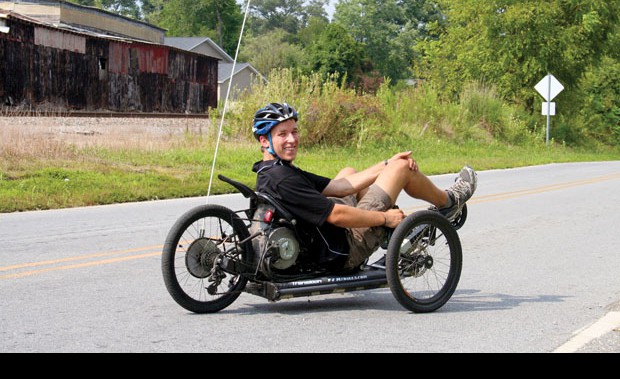![]()
Let’s get one thing straight: Recumbent bicycles aren’t for nerds. Sure, these odd-looking bicycles may have gotten that reputation somewhere along the way (maybe it’s because recumbents typically look like patio loungers on wheels, or maybe it’s the tricycle association–most recreational recumbents have three wheels), but the recumbent bike that I’m riding at 32 mph down a country road on the edge of Pisgah National Forest is not nerdy. I’m going too damn fast and having too much fun for this thing to be considered nerdy. I come out of a corner, lay on the throttle to push the electric motor to its limit and start pedaling hard. On a long straightaway, I get a kick out of watching the speedometer creep up…33, 34…before pulling up to the stoplight next to Tommy Ausherman, who’s also rocking a recumbent.
“Well? he asks.
“I feel like I’m 12, and I just discovered go-karts,” I tell him.
24-year-old Ausherman is the founder of FFR Trikes, a company that builds these very sleek, very fast, decidedly non-nerdy electric-powered recumbent bicycles. The machines are geared to top out in the 35 mph range, will go up to 40 miles on a single charge, and can be plugged into any wall socket and recharge within an hour. The model I’m riding is the Transition One, so-named because Ausherman and his partners think this is the vehicle that can help Americans transition out of their cars.
“The average trip Americans take is under 10 miles,” says Jesse Lee, one of the FFR Trikes partners. “Commuting to work, going to the coffee shop, the grocery store…this thing is perfect.”
Ausherman created his first electric trike out of a very practical need. He was going to school at Appalachian State University, commuting five miles each way on his mountain bike, and getting blown off the road by cars and trucks. But a parking permit at the school was $500, so getting a car was out.
“I wanted a bike that could keep up with traffic, so I built this 22-pound electric engine and threw it on my steel Trek mountain bike,” Ausherman says. “Going that fast on an upright is a bit scary, and you’ve got wind drag issues, so I looked into the recumbent.”
Recumbent bicycles are far more aerodynamic than upright bikes, more stable at high speeds, and typically go much faster even without the assistance of a motor because the cyclist is using larger muscle groups (pedaling a recumbent is like doing leg presses). Ausherman bought an off-road steel recumbent, attached his self-designed rechargeable engine, and FFR Trikes was born.
He’s put 8,000 miles on that first model and sold half a dozen others to customers in the last two years. The model I tested has a solid steel frame, burly BMX tires, mountain bike components, and a three-pound, svelte engine designed by Ausherman and Lee and built by one of their partners in a machine shop in Charlotte. It has a rack to hold panniers, and another attachment to tow an upright bike off the tail. And it corners like a dream. Lean into a turn and squeeze the inside differential brake, and you can whip these little machines around a tight mountain switchback like a redneck on a crotch-rocket. You get all this for just under $6,000, roughly the price of a really, really nice mountain bike.
Given the versatility and speed of the trikes, Ausherman is hoping his machines will catch on as an alternative to the second family car. “This model addresses a lot of the stumbling blocks that have kept other electric bikes from catching on in America,” he says. “Most electric bikes top out at 20 mph, not fast enough to ‘take the lane’ on surface streets. But the Transition One was designed to keep up with traffic. It bridges the gap between the electric bike and the electric car. Plus, it’s a blast.”
Therein lies the true genius behind the FFR Trike Transition One. It’s fun in a way that other practicality-minded electric bikes and electric cars aren’t. On the Transition One, you’re low to the ground, you’re going fast, and you’re completely exposed to the elements. It’s a combination that is absolutely exhilarating and it makes me believe this trike would shine on a Blue Ridge Parkway ride or ripping along a forest road deep inside Pisgah National Forest.
“I’d love to see this catch on as an adventure vehicle,” Ausherman says. “It’s a great shuttle vehicle, and it’s a lot more fun to get to the top of a trailhead in this than in a car. It’s like riding a motorcycle, but there’s more physical involvement.”
He’s created a road-worthy, pedal-assisted vehicle that you can ride for 40 miles on a single charge, plug into any socket for an hour and ride 40 miles back. And the Transition One is just the beginning.
“I’m always pushing in the shop, trying to figure out how fast and how far we can go.”
To the Limit
Still think recumbents are geeky? Consider this: recumbent bicycles are so fast, they were banned from international racing in the ‘30s. And the human-powered bike speed record was set by a recumbent cyclist. Sam Whittingham pedaled his svelte recumbent to a top speed of 82.3 miles per hour on a very flat road in Nevada in 2008.








